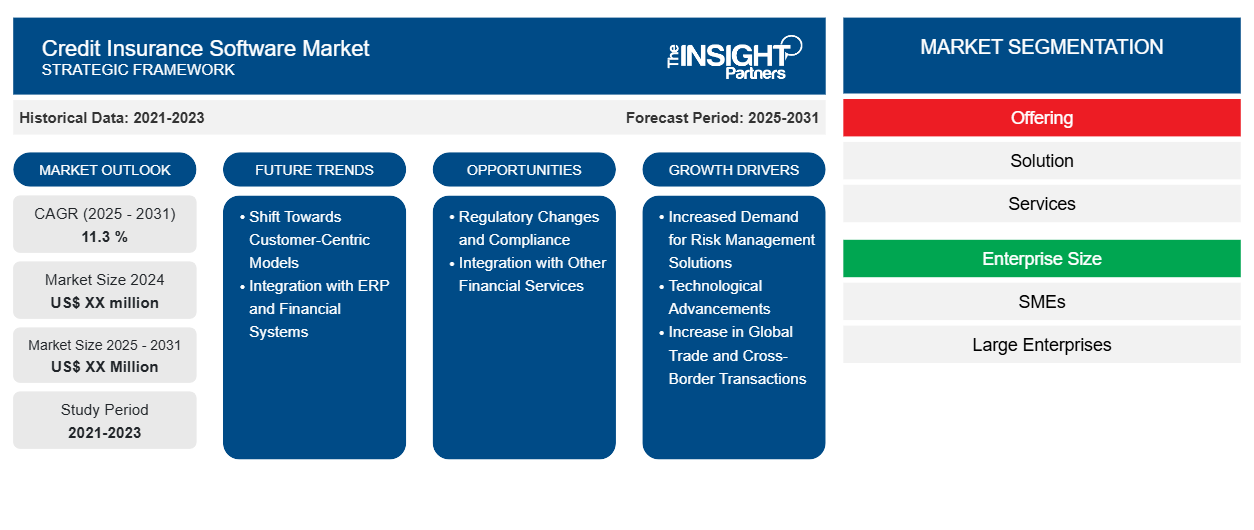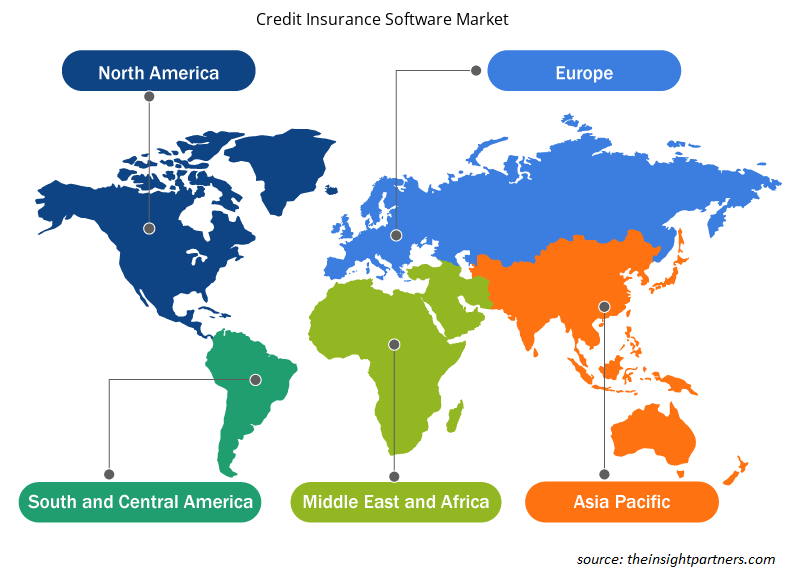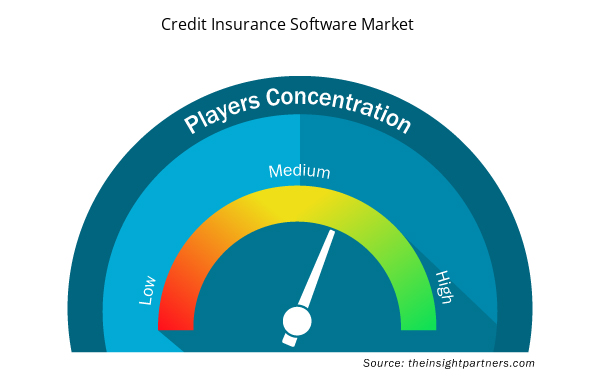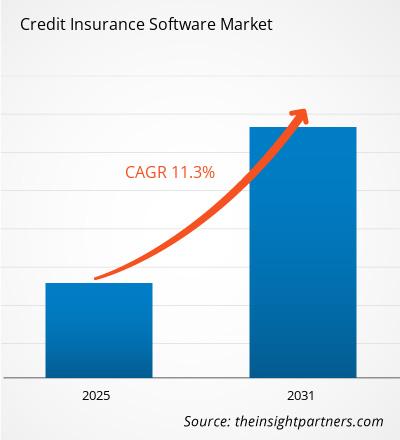The Credit Insurance Software Market is expected to register a CAGR of 11.3 % from 2025 to 2031, with a market size expanding from US$ XX million in 2024 to US$ XX Million by 2031.
The report is segmented by Offering (Solution, Services); Enterprise Size (SMEs, Large Enterprises). The global analysis is further broken-down at regional level and major countries. The report offers the value in USD for the above analysis and segments
Purpose of the Report
The report Credit Insurance Software Market by The Insight Partners aims to describe the present landscape and future growth, top driving factors, challenges, and opportunities. This will provide insights to various business stakeholders, such as:
- Technology Providers/Manufacturers: To understand the evolving market dynamics and know the potential growth opportunities, enabling them to make informed strategic decisions.
- Investors: To conduct a comprehensive trend analysis regarding the market growth rate, market financial projections, and opportunities that exist across the value chain.
- Regulatory bodies: To regulate policies and police activities in the market with the aim of minimizing abuse, preserving investor trust and confidence, and upholding the integrity and stability of the market.
Credit Insurance Software Market Segmentation
Offering
- Solution
- Services
Enterprise Size
- SMEs
- Large Enterprises
Customize This Report To Suit Your Requirement
You will get customization on any report - free of charge - including parts of this report, or country-level analysis, Excel Data pack, as well as avail great offers and discounts for start-ups & universities
Credit Insurance Software Market: Strategic Insights

- Get Top Key Market Trends of this report.This FREE sample will include data analysis, ranging from market trends to estimates and forecasts.
Credit Insurance Software Market Growth Drivers
- Increased Demand for Risk Management Solutions: The increasing complexity of global trade and rising credit risks have significantly increased the demand for credit insurance software. Businesses now realize the importance of safeguarding their accounts receivable against defaults and insolvencies. This is triggered by the emergent needs for more extensive tools that can conduct real-time assessments about the creditworthiness of clients and partners in order to inform decisions and reduce potential losses for the firm.
- Technological Advancements: The curve of technology is moving upwards, especially in data analytics and artificial intelligence. Currently, software solutions could collect large amounts of data that would help the risk to be identified quickly and more accurately. With this kind of advancement, the insurer would be able to have better-tailored products and services for its customers, thus bringing up a very good level of satisfaction and retention of customers. Business will, therefore seek to harness these new revolutions-credit insurance software-so its likelihood of demand will rise.
- Increase in Global Trade and Cross-Border Transactions: The expansion of international trade and cross-border business transactions is another key driver for the credit insurance software market. With businesses engaging in more global trade, they are exposed to higher risks related to customer insolvency or payment delays across different countries and currencies. Credit insurance software helps companies evaluate and manage risks in these transactions, facilitating more secure and efficient cross-border business operations, which drives demand for such solutions.
Credit Insurance Software Market Future Trends
- Shift Towards Customer-Centric Models : The credit insurance industry is witnessing a paradigm shift toward more customer-centric business models. Now, the need is on individual client-specific requirements and how the products can be crafted in response to these requirements. Credit insurance software is developing to accommodate the flexibility of policy offerings with added customization abilities in order to meet the requirements of high-quality customized services for more customer loyalty and satisfaction.
- Integration with ERP and Financial Systems: An increasing trend in the credit insurance software market is the integration of these solutions with Enterprise Resource Planning (ERP) systems, Customer Relationship Management (CRM) software, and other financial platforms. This integration enables businesses to centralize data, improve efficiency, and make better-informed decisions regarding credit risk management. By connecting credit insurance software with existing enterprise systems, organizations can seamlessly monitor and manage credit exposures in real time, facilitating more informed financial decisions and risk management.
Credit Insurance Software Market Opportunities
- Regulatory Changes and Compliance:
This industry undertakes ongoing regulatory changes with regard to credit insurance, and these are also aimed towards greater transparency and accountability. Businesses are, therefore developing software solutions to enable them to better comply with these regulations. Thus, the firms not only respect legal requirements but also gain the trust of clients and other stakeholders who could attest to the firms' rightful commitment to risk management practices. - Integration with Other Financial Services:
Emerging markets also have substantial growth opportunities in the context of cybersecurity services. As these regions continue to digitize and encounter intensified cyber Integration with other financial services Integration of credit insurance software with other financial services like credit management and risk assessment tools enables a wholesome value proposition. With a fuller bouquet of services, providers will have the ability to improve their relationship with clients in the long run, as customers like to strike a deal where all their needs are met by the same service provider through a single platform.
Credit Insurance Software Market Regional Insights
The regional trends and factors influencing the Credit Insurance Software Market throughout the forecast period have been thoroughly explained by the analysts at Insight Partners. This section also discusses Credit Insurance Software Market segments and geography across North America, Europe, Asia Pacific, Middle East and Africa, and South and Central America.

- Get the Regional Specific Data for Credit Insurance Software Market
Credit Insurance Software Market Report Scope
| Report Attribute | Details |
|---|---|
| Market size in 2024 | US$ XX million |
| Market Size by 2031 | US$ XX Million |
| Global CAGR (2025 - 2031) | 11.3 % |
| Historical Data | 2021-2023 |
| Forecast period | 2025-2031 |
| Segments Covered |
By Offering
|
| Regions and Countries Covered | North America
|
| Market leaders and key company profiles |
Credit Insurance Software Market Players Density: Understanding Its Impact on Business Dynamics
The Credit Insurance Software Market market is growing rapidly, driven by increasing end-user demand due to factors such as evolving consumer preferences, technological advancements, and greater awareness of the product's benefits. As demand rises, businesses are expanding their offerings, innovating to meet consumer needs, and capitalizing on emerging trends, which further fuels market growth.
Market players density refers to the distribution of firms or companies operating within a particular market or industry. It indicates how many competitors (market players) are present in a given market space relative to its size or total market value.
Major Companies operating in the Credit Insurance Software Market are:
- Codix
- Coface
- Collenda
- Comarch SA
- DXC Technology Company
- ESKADENIA Software
Disclaimer: The companies listed above are not ranked in any particular order.

- Get the Credit Insurance Software Market top key players overview
Key Selling Points
- Comprehensive Coverage: The report comprehensively covers the analysis of products, services, types, and end users of the Credit Insurance Software Market, providing a holistic landscape.
- Expert Analysis: The report is compiled based on the in-depth understanding of industry experts and analysts.
- Up-to-date Information: The report assures business relevance due to its coverage of recent information and data trends.
- Customization Options: This report can be customized to cater to specific client requirements and suit the business strategies aptly.
The research report on the Credit Insurance Software Market can, therefore, help spearhead the trail of decoding and understanding the industry scenario and growth prospects. Although there can be a few valid concerns, the overall benefits of this report tend to outweigh the disadvantages.
- Historical Analysis (2 Years), Base Year, Forecast (7 Years) with CAGR
- PEST and SWOT Analysis
- Market Size Value / Volume - Global, Regional, Country
- Industry and Competitive Landscape
- Excel Dataset



Report Coverage
Revenue forecast, Company Analysis, Industry landscape, Growth factors, and Trends

Segment Covered
This text is related
to segments covered.

Regional Scope
North America, Europe, Asia Pacific, Middle East & Africa, South & Central America

Country Scope
This text is related
to country scope.
Frequently Asked Questions
Some of the customization options available based on the request are an additional 3–5 company profiles and country-specific analysis of 3–5 countries of your choice. Customizations are to be requested/discussed before making final order confirmation# as our team would review the same and check the feasibility
The report can be delivered in PDF/PPT format; we can also share excel dataset based on the request
Shift towards customer-centric models is anticipated to play a significant role in the global credit insurance software market in the coming years
The major factors driving the credit insurance software market are:
1. Increased Demand for Risk Management Solutions::
2. Technological Advancements
The credit insurance software market is estimated to witness a US$ XX million in 2024
Trends and growth analysis reports related to Technology, Media and Telecommunications : READ MORE..
1. Codix
2. Coface
3. Collenda
4. Comarch SA
5. DXC Technology Company
6. ESKADENIA Software
7. EULER HERMES
8. Onguard
9. SCHUMANN
10. Tinubu Square

 Get Free Sample For
Get Free Sample For